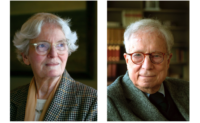In the popular imagination, Denise Scott Brown is immortalized in a single image from 1966: With the Las Vegas Strip in the distance, she strikes a defiant pose—hands on her hips with a smirk as wide as her stance.
“I was hamming,” Scott Brown, 84, says now of the photograph. “I learned from one of my professors at Penn that if you have passion, your students won’t know it unless you ham your passion; You have to really put it on.”
“It’s been made into an Emoji,” she adds.
This photograph may encapsulate Scott Brown’s cult status as both architectural and feminist icon, but it also alludes to her enduring relationship with photography. An exhibition on view this summer as part of the Venice Architecture Biennale at the Palazzo Mora, designed and curated by Scott Brown, chronicles two formative decades in which she documented cities—from Venice, Italy, to Venice, California.
“I am not a photographer,” Scott Brown writes in the exhibition text. “I shoot for architecture—if there’s art here it’s a byproduct. Yet the images stand alone; Judge what you see.”
The exhibition, called the Wayward Eye, begins with Scott Brown’s early expeditions as an architect. This “Grand Tour,” as she calls it, started in 1956 with her first husband, Robert Scott Brown, while attending a summer school in Venice organized by the influential Congrès International d’Architecture Moderne. Armed with two Alpa cameras, three lenses, a trove of color film, and a Modernist mindset, the pair set out to compile a visual log to bring back to their native South Africa.
Initially, they applied the Modernist principles they learned at architecture school to document the city and its classical structures. But they became captivated by the work of French street photographer Henri Cartier-Bresson: “We looked long and hard at his pictures,” Scott Brown remembers. They were also influenced by Modern art. Through the young couple’s lenses, peeling posters became Braque paintings; windows echoed the rigid geometries of Mondrian.
“We were still documenting and getting data, but it was a different kind of data,” Scott Brown says.
One of Wayward Eye’s preliminary images—composed by both Denise and Robert—depicts a man alone in Piazza San Marco being engulfed by a flock of pigeons, their pleated wings in razor-sharp focus. It is the exhibition's sole black-and-white photo and, as a standalone object, one of the collection’s most compelling. But throughout the exhibition, Scott Brown refuses to privilege one image over another: Six smaller photographs abutting the black-and-white image depict acrobats on Venice Beach tumbling through the sky—just like the Italian pigeons.
Scott Brown finds joy in these formal juxtapositions. In another sequence, the prows of Venetian gondolas mirror an image of vertical surfboards poking out of Californian sand. “The relationships are so important—one plus one is more than two,” Scott Brown says of the exhibition’s oversized collaged panels.
She continues, “That’s urbanism: Jamming them together and not studying them separately.”
Urbanism also informed Wayward Eye’s plan, which takes inspiration from Venice itself. Towering panels—teeming with images—are oriented about the gallery’s central space, an area Scott Brown refers to as the campo, or town square. “My view is urbanistic even if it’s a teaspoon,” she insists.
Just off the campo, viewers enter the next decade of Scott Brown’s Grand Tour—the American Southwest. Shortly after Robert’s untimely death in 1959, Scott Brown left Penn to teach at the University of California, Berkeley and later UCLA. “By the time I was in California, I was shooting like crazy,” she says. This time she focused on the hallmarks of the region’s arid, automobile cities—vernacular buildings, car culture, neon signage—“Things that would shock you and open up your eyes and might make you aesthetically more sensitive,” Scott Brown says.
She took a special interest in Las Vegas, along with her second husband and architectural partner Robert Venturi, under the unlikely proposition, “Could Las Vegas be educational?”
One portion of the exhibition depicts an array of blazing signs lining the Las Vegas Strip, advertising casinos, bars, and hotels. Such urban portraiture laid the groundwork for her legendary studio course and book with Venturi and Steven Izenour, Learning from Las Vegas. “We went from analysis to synthesis,” she explains. “As Lou Kahn used to say, ‘Before there is a how, there is a what.’” She showed the slides to her students for years.
Another section of the show features sun-bleached daytime shots that seem to radiate the desert heat reflecting from freeways and car lots. Los Angeles, meanwhile, is a tangle of telephone wires, while staid images of the Mojave Desert recall the vastness of Scott Brown’s first love—the South African veldt.
It is tempting to compare many of these images to those shot by Ed Ruscha in the early ‘60s. But where Ruscha’s images of gas stations and swimming pools present a visual poker-face, Scott Brown’s greet the viewer with a wink: A Las Vegas sign advertising “Termite Pest Control” is positioned adjacent to one that reads “Free Aspirin Ask Us Anything.” In another image—the photographic opposite of her own iconic Las Vegas portrait—she styled Venturi from the back à la Magritte in a black suit, silhouetted against the Strip.
The Grand Tour never really ended for Scott Brown. Though she no longer travels and an iPhone has replaced the old Alpa, her photographic approach remains unchanged. “You don’t think, you shoot,” she says. “Because by the time you’ve worked out with yourself why you want that thing, it’s gone."
Wayward Eye: The Photography of Denise Scott Brown is on view at the Palazzo Mora in Venice until November 28. The exhibition was created in partnership with the Global Art Affairs Foundation and is also the subject of an upcoming book by Metropolis Press.

































